Essay: Deconstruction of Aboriginal Health and Wellbeing in Australia
VerifiedAdded on 2020/04/15
|9
|1792
|36
Essay
AI Summary
This essay undertakes a deconstruction of the question, "Why don’t Aboriginals take an interest in health and wellbeing?" It begins by examining the historical context of European colonization and its devastating impact on Aboriginal Australians, including disease, displacement, and the "Stolen Generation." The essay highlights the systemic racism and discrimination faced by Aboriginal people, including the Flora and Fauna Act and "White Privilege," which have resulted in significant health inequalities. It critiques the use of inappropriate terminologies and explores the social determinants of health, such as poverty, lack of access to healthcare, and the impact of colonization. The essay concludes that Aboriginal health issues are deeply rooted in historical injustices and ongoing systemic barriers, emphasizing the need for a comprehensive understanding of these factors to address health disparities. The essay argues that the question itself is unfair, given the history and consequences faced by Aboriginal people in all aspects of life, and calls for a more nuanced approach to understanding and improving their health and wellbeing.
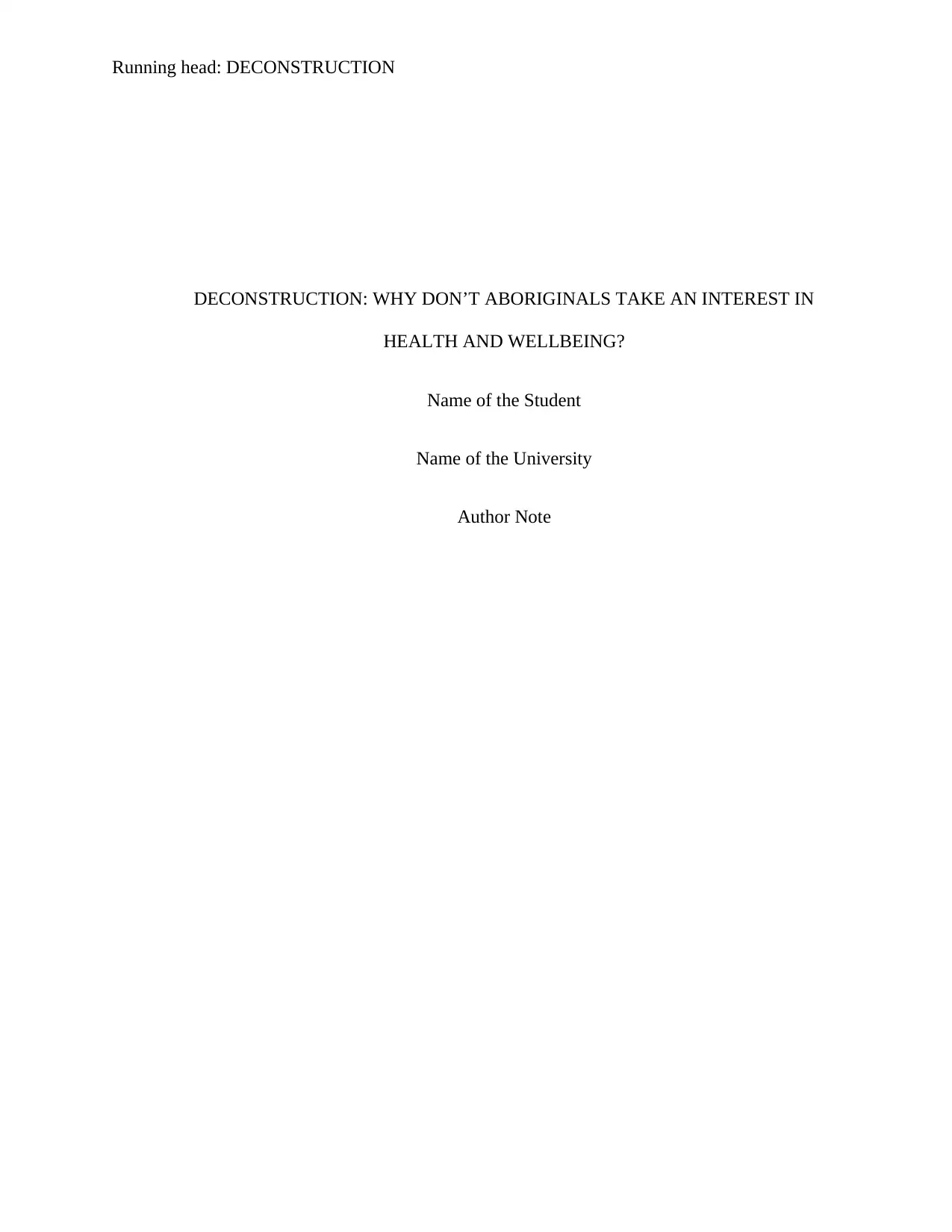
Running head: DECONSTRUCTION
DECONSTRUCTION: WHY DON’T ABORIGINALS TAKE AN INTEREST IN
HEALTH AND WELLBEING?
Name of the Student
Name of the University
Author Note
DECONSTRUCTION: WHY DON’T ABORIGINALS TAKE AN INTEREST IN
HEALTH AND WELLBEING?
Name of the Student
Name of the University
Author Note
Paraphrase This Document
Need a fresh take? Get an instant paraphrase of this document with our AI Paraphraser

1DECONSTRUCTION
Table of Contents
Introduction......................................................................................................................................2
The Stolen Generation.....................................................................................................................3
The Flora and Fauna act/White Privilege........................................................................................3
Wrong Terminologies......................................................................................................................4
Social determinants of health...........................................................................................................4
Conclusion.......................................................................................................................................5
Reference List..................................................................................................................................6
Table of Contents
Introduction......................................................................................................................................2
The Stolen Generation.....................................................................................................................3
The Flora and Fauna act/White Privilege........................................................................................3
Wrong Terminologies......................................................................................................................4
Social determinants of health...........................................................................................................4
Conclusion.......................................................................................................................................5
Reference List..................................................................................................................................6
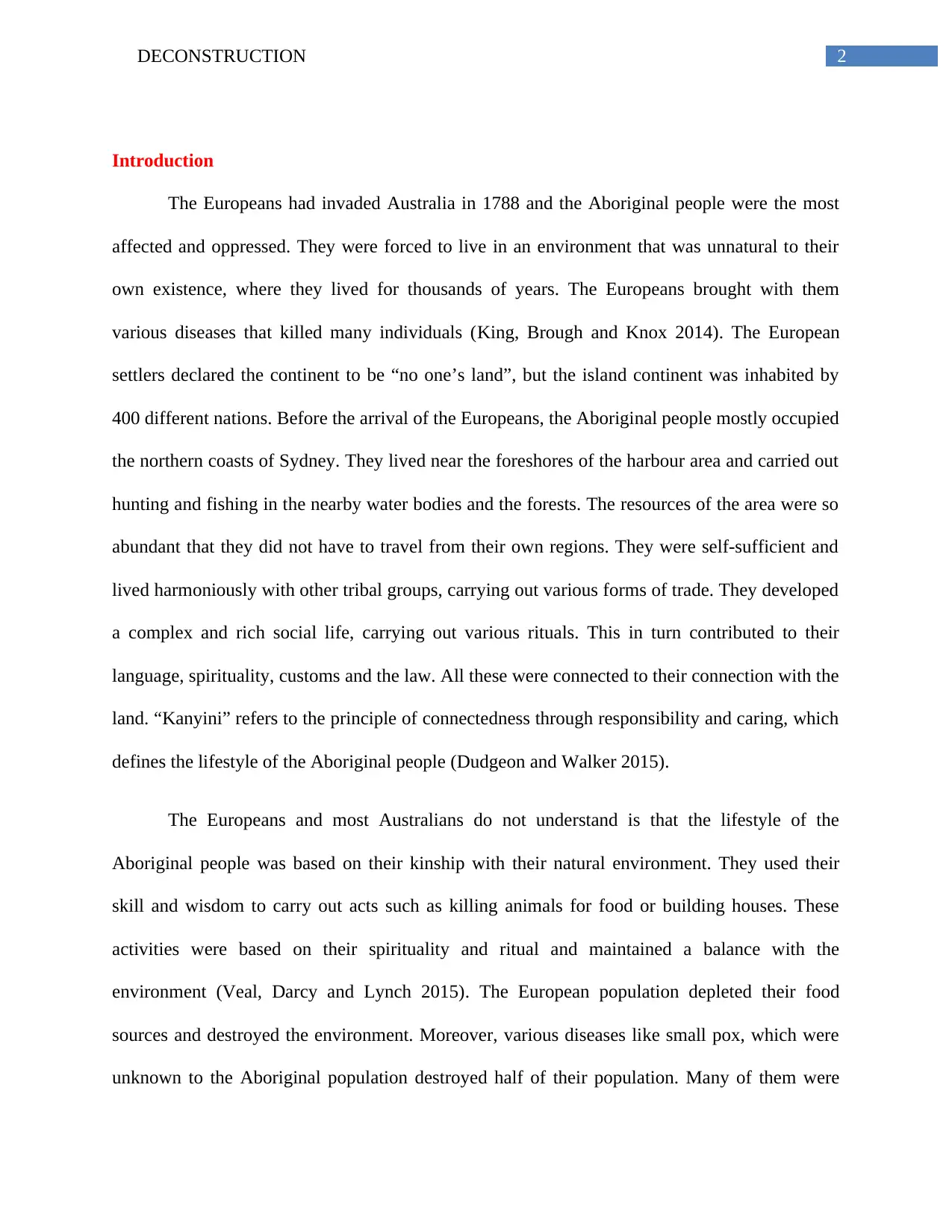
2DECONSTRUCTION
Introduction
The Europeans had invaded Australia in 1788 and the Aboriginal people were the most
affected and oppressed. They were forced to live in an environment that was unnatural to their
own existence, where they lived for thousands of years. The Europeans brought with them
various diseases that killed many individuals (King, Brough and Knox 2014). The European
settlers declared the continent to be “no one’s land”, but the island continent was inhabited by
400 different nations. Before the arrival of the Europeans, the Aboriginal people mostly occupied
the northern coasts of Sydney. They lived near the foreshores of the harbour area and carried out
hunting and fishing in the nearby water bodies and the forests. The resources of the area were so
abundant that they did not have to travel from their own regions. They were self-sufficient and
lived harmoniously with other tribal groups, carrying out various forms of trade. They developed
a complex and rich social life, carrying out various rituals. This in turn contributed to their
language, spirituality, customs and the law. All these were connected to their connection with the
land. “Kanyini” refers to the principle of connectedness through responsibility and caring, which
defines the lifestyle of the Aboriginal people (Dudgeon and Walker 2015).
The Europeans and most Australians do not understand is that the lifestyle of the
Aboriginal people was based on their kinship with their natural environment. They used their
skill and wisdom to carry out acts such as killing animals for food or building houses. These
activities were based on their spirituality and ritual and maintained a balance with the
environment (Veal, Darcy and Lynch 2015). The European population depleted their food
sources and destroyed the environment. Moreover, various diseases like small pox, which were
unknown to the Aboriginal population destroyed half of their population. Many of them were
Introduction
The Europeans had invaded Australia in 1788 and the Aboriginal people were the most
affected and oppressed. They were forced to live in an environment that was unnatural to their
own existence, where they lived for thousands of years. The Europeans brought with them
various diseases that killed many individuals (King, Brough and Knox 2014). The European
settlers declared the continent to be “no one’s land”, but the island continent was inhabited by
400 different nations. Before the arrival of the Europeans, the Aboriginal people mostly occupied
the northern coasts of Sydney. They lived near the foreshores of the harbour area and carried out
hunting and fishing in the nearby water bodies and the forests. The resources of the area were so
abundant that they did not have to travel from their own regions. They were self-sufficient and
lived harmoniously with other tribal groups, carrying out various forms of trade. They developed
a complex and rich social life, carrying out various rituals. This in turn contributed to their
language, spirituality, customs and the law. All these were connected to their connection with the
land. “Kanyini” refers to the principle of connectedness through responsibility and caring, which
defines the lifestyle of the Aboriginal people (Dudgeon and Walker 2015).
The Europeans and most Australians do not understand is that the lifestyle of the
Aboriginal people was based on their kinship with their natural environment. They used their
skill and wisdom to carry out acts such as killing animals for food or building houses. These
activities were based on their spirituality and ritual and maintained a balance with the
environment (Veal, Darcy and Lynch 2015). The European population depleted their food
sources and destroyed the environment. Moreover, various diseases like small pox, which were
unknown to the Aboriginal population destroyed half of their population. Many of them were
⊘ This is a preview!⊘
Do you want full access?
Subscribe today to unlock all pages.

Trusted by 1+ million students worldwide
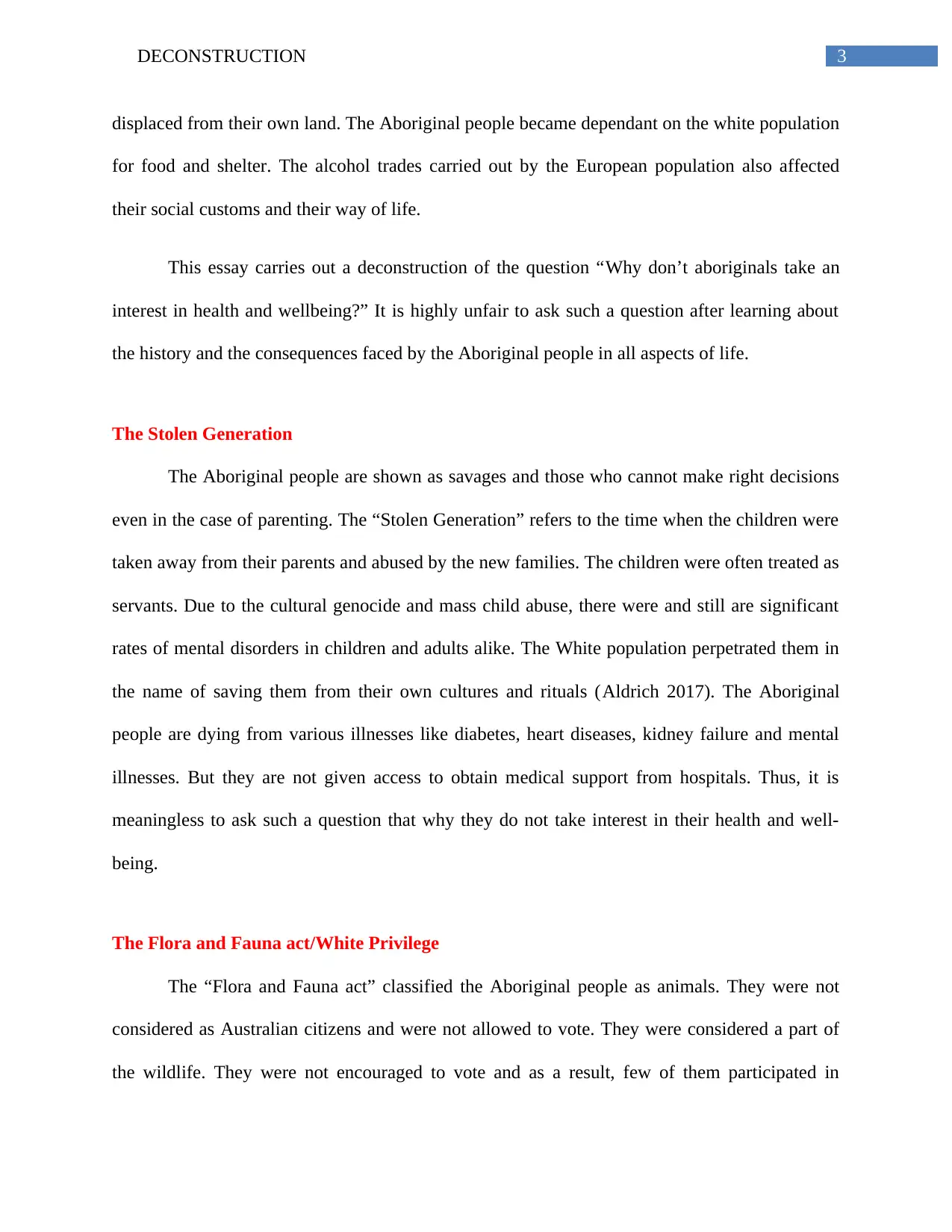
3DECONSTRUCTION
displaced from their own land. The Aboriginal people became dependant on the white population
for food and shelter. The alcohol trades carried out by the European population also affected
their social customs and their way of life.
This essay carries out a deconstruction of the question “Why don’t aboriginals take an
interest in health and wellbeing?” It is highly unfair to ask such a question after learning about
the history and the consequences faced by the Aboriginal people in all aspects of life.
The Stolen Generation
The Aboriginal people are shown as savages and those who cannot make right decisions
even in the case of parenting. The “Stolen Generation” refers to the time when the children were
taken away from their parents and abused by the new families. The children were often treated as
servants. Due to the cultural genocide and mass child abuse, there were and still are significant
rates of mental disorders in children and adults alike. The White population perpetrated them in
the name of saving them from their own cultures and rituals (Aldrich 2017). The Aboriginal
people are dying from various illnesses like diabetes, heart diseases, kidney failure and mental
illnesses. But they are not given access to obtain medical support from hospitals. Thus, it is
meaningless to ask such a question that why they do not take interest in their health and well-
being.
The Flora and Fauna act/White Privilege
The “Flora and Fauna act” classified the Aboriginal people as animals. They were not
considered as Australian citizens and were not allowed to vote. They were considered a part of
the wildlife. They were not encouraged to vote and as a result, few of them participated in
displaced from their own land. The Aboriginal people became dependant on the white population
for food and shelter. The alcohol trades carried out by the European population also affected
their social customs and their way of life.
This essay carries out a deconstruction of the question “Why don’t aboriginals take an
interest in health and wellbeing?” It is highly unfair to ask such a question after learning about
the history and the consequences faced by the Aboriginal people in all aspects of life.
The Stolen Generation
The Aboriginal people are shown as savages and those who cannot make right decisions
even in the case of parenting. The “Stolen Generation” refers to the time when the children were
taken away from their parents and abused by the new families. The children were often treated as
servants. Due to the cultural genocide and mass child abuse, there were and still are significant
rates of mental disorders in children and adults alike. The White population perpetrated them in
the name of saving them from their own cultures and rituals (Aldrich 2017). The Aboriginal
people are dying from various illnesses like diabetes, heart diseases, kidney failure and mental
illnesses. But they are not given access to obtain medical support from hospitals. Thus, it is
meaningless to ask such a question that why they do not take interest in their health and well-
being.
The Flora and Fauna act/White Privilege
The “Flora and Fauna act” classified the Aboriginal people as animals. They were not
considered as Australian citizens and were not allowed to vote. They were considered a part of
the wildlife. They were not encouraged to vote and as a result, few of them participated in
Paraphrase This Document
Need a fresh take? Get an instant paraphrase of this document with our AI Paraphraser
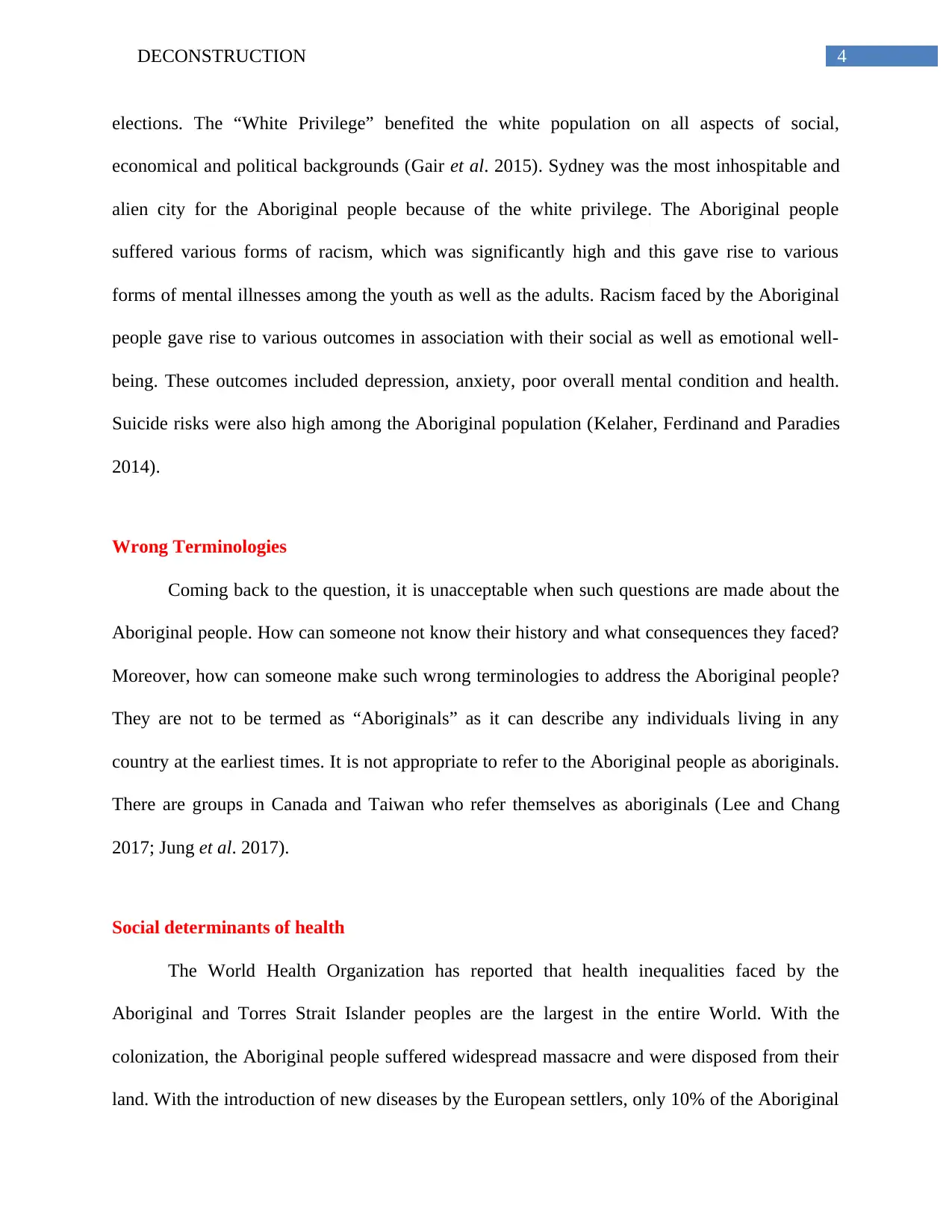
4DECONSTRUCTION
elections. The “White Privilege” benefited the white population on all aspects of social,
economical and political backgrounds (Gair et al. 2015). Sydney was the most inhospitable and
alien city for the Aboriginal people because of the white privilege. The Aboriginal people
suffered various forms of racism, which was significantly high and this gave rise to various
forms of mental illnesses among the youth as well as the adults. Racism faced by the Aboriginal
people gave rise to various outcomes in association with their social as well as emotional well-
being. These outcomes included depression, anxiety, poor overall mental condition and health.
Suicide risks were also high among the Aboriginal population (Kelaher, Ferdinand and Paradies
2014).
Wrong Terminologies
Coming back to the question, it is unacceptable when such questions are made about the
Aboriginal people. How can someone not know their history and what consequences they faced?
Moreover, how can someone make such wrong terminologies to address the Aboriginal people?
They are not to be termed as “Aboriginals” as it can describe any individuals living in any
country at the earliest times. It is not appropriate to refer to the Aboriginal people as aboriginals.
There are groups in Canada and Taiwan who refer themselves as aboriginals (Lee and Chang
2017; Jung et al. 2017).
Social determinants of health
The World Health Organization has reported that health inequalities faced by the
Aboriginal and Torres Strait Islander peoples are the largest in the entire World. With the
colonization, the Aboriginal people suffered widespread massacre and were disposed from their
land. With the introduction of new diseases by the European settlers, only 10% of the Aboriginal
elections. The “White Privilege” benefited the white population on all aspects of social,
economical and political backgrounds (Gair et al. 2015). Sydney was the most inhospitable and
alien city for the Aboriginal people because of the white privilege. The Aboriginal people
suffered various forms of racism, which was significantly high and this gave rise to various
forms of mental illnesses among the youth as well as the adults. Racism faced by the Aboriginal
people gave rise to various outcomes in association with their social as well as emotional well-
being. These outcomes included depression, anxiety, poor overall mental condition and health.
Suicide risks were also high among the Aboriginal population (Kelaher, Ferdinand and Paradies
2014).
Wrong Terminologies
Coming back to the question, it is unacceptable when such questions are made about the
Aboriginal people. How can someone not know their history and what consequences they faced?
Moreover, how can someone make such wrong terminologies to address the Aboriginal people?
They are not to be termed as “Aboriginals” as it can describe any individuals living in any
country at the earliest times. It is not appropriate to refer to the Aboriginal people as aboriginals.
There are groups in Canada and Taiwan who refer themselves as aboriginals (Lee and Chang
2017; Jung et al. 2017).
Social determinants of health
The World Health Organization has reported that health inequalities faced by the
Aboriginal and Torres Strait Islander peoples are the largest in the entire World. With the
colonization, the Aboriginal people suffered widespread massacre and were disposed from their
land. With the introduction of new diseases by the European settlers, only 10% of the Aboriginal

5DECONSTRUCTION
and Torres Strait Islander people remained. The inequality and the poverty they face are a
reflection of the previous treatments faced by them as reported in history. Systematic
discrimination is responsible for the health inequalities faced by them (Markwick et al. 2014).
Colonization created several barriers to improving the health of the Aboriginal and Torres
Strait Islander peoples. These barriers are on many levels like the interactions between
physicians and patients, delivery of health or medical services and the wider economic as well as
the political stage. The constant debate about the inadequacy and dysfunction of the Aboriginal
and Torres Strait Islander peoples association with public health practices disconnects them from
their own culture and identities. Moreover, due to the biomedical models, public health programs
are directed towards lifestyle issues. This in turn reinforces and causes perpetuation of racism
and prejudice, which are a key determinant leading to the poor health of the Aboriginal people.
Health education disempowers and reinstates the feeling of low self esteem among the
Aboriginal population. The health services ignores the social, cultural and emotional well-being
of the Aboriginal people. The Aboriginal people suffer from various forms of distress that affect
their health. These are the socio-economic determinants, psychosocial factors like food
insecurity, very high psychological distress and financial stress. There are also high numbers of
them, who did not get help from the community services and resources (Ralph and Ryan 2017).
Conclusion
Thus, it can be concluded that the Aboriginal people suffer from various disadvantages
like poor income and employment rates, they have trust issues, which stems from the racism
faced by them. These trust issues prevents them from utilizing health services, thereby resulting
and Torres Strait Islander people remained. The inequality and the poverty they face are a
reflection of the previous treatments faced by them as reported in history. Systematic
discrimination is responsible for the health inequalities faced by them (Markwick et al. 2014).
Colonization created several barriers to improving the health of the Aboriginal and Torres
Strait Islander peoples. These barriers are on many levels like the interactions between
physicians and patients, delivery of health or medical services and the wider economic as well as
the political stage. The constant debate about the inadequacy and dysfunction of the Aboriginal
and Torres Strait Islander peoples association with public health practices disconnects them from
their own culture and identities. Moreover, due to the biomedical models, public health programs
are directed towards lifestyle issues. This in turn reinforces and causes perpetuation of racism
and prejudice, which are a key determinant leading to the poor health of the Aboriginal people.
Health education disempowers and reinstates the feeling of low self esteem among the
Aboriginal population. The health services ignores the social, cultural and emotional well-being
of the Aboriginal people. The Aboriginal people suffer from various forms of distress that affect
their health. These are the socio-economic determinants, psychosocial factors like food
insecurity, very high psychological distress and financial stress. There are also high numbers of
them, who did not get help from the community services and resources (Ralph and Ryan 2017).
Conclusion
Thus, it can be concluded that the Aboriginal people suffer from various disadvantages
like poor income and employment rates, they have trust issues, which stems from the racism
faced by them. These trust issues prevents them from utilizing health services, thereby resulting
⊘ This is a preview!⊘
Do you want full access?
Subscribe today to unlock all pages.

Trusted by 1+ million students worldwide
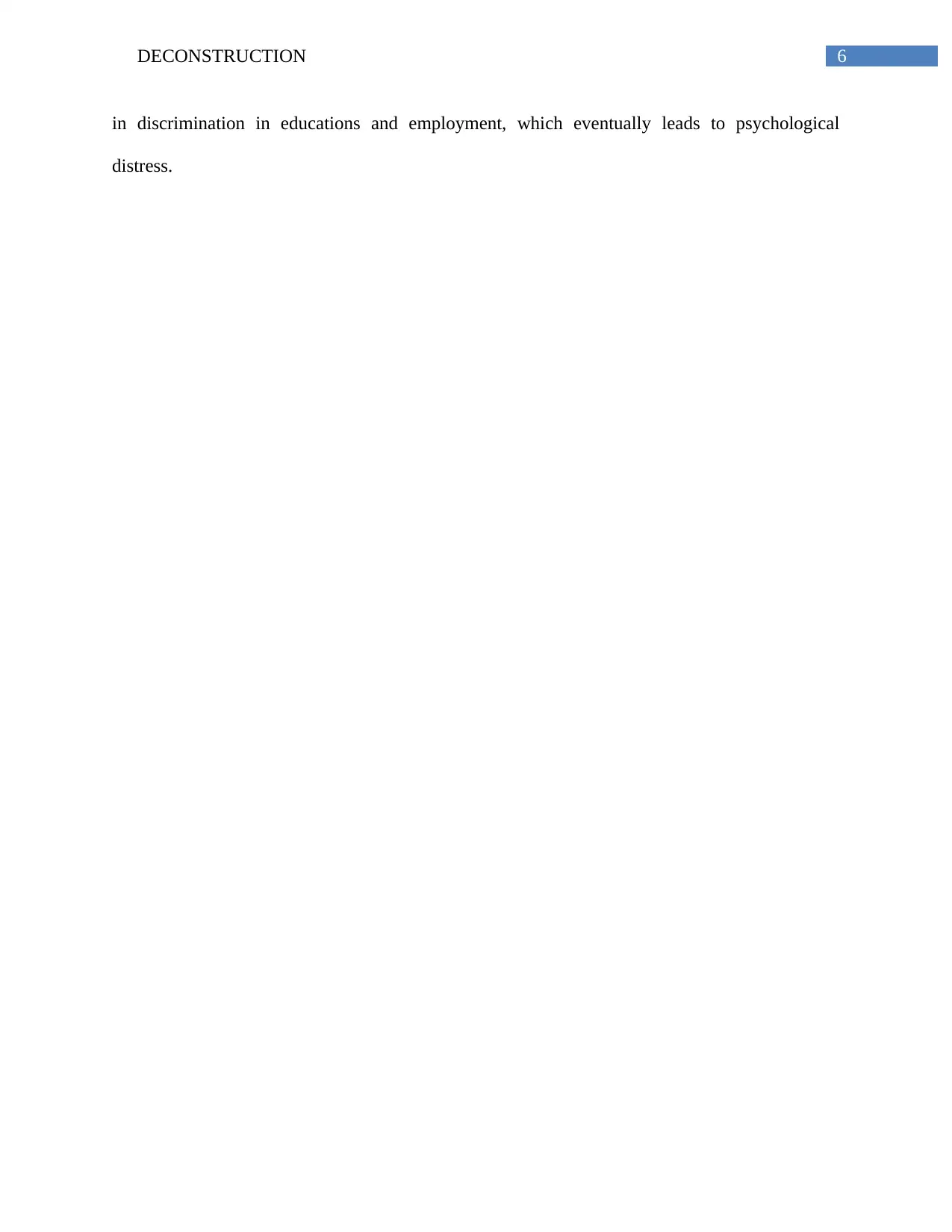
6DECONSTRUCTION
in discrimination in educations and employment, which eventually leads to psychological
distress.
in discrimination in educations and employment, which eventually leads to psychological
distress.
Paraphrase This Document
Need a fresh take? Get an instant paraphrase of this document with our AI Paraphraser
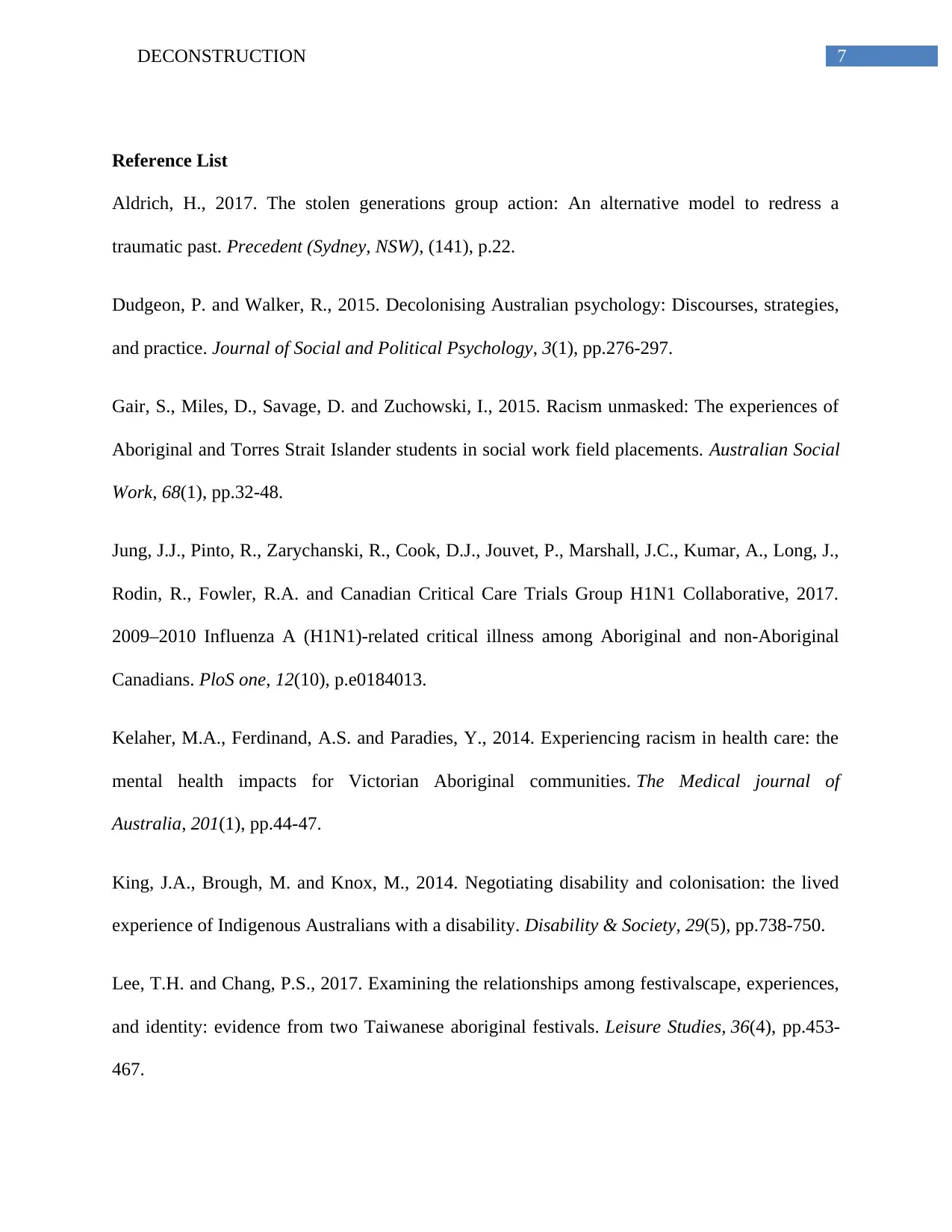
7DECONSTRUCTION
Reference List
Aldrich, H., 2017. The stolen generations group action: An alternative model to redress a
traumatic past. Precedent (Sydney, NSW), (141), p.22.
Dudgeon, P. and Walker, R., 2015. Decolonising Australian psychology: Discourses, strategies,
and practice. Journal of Social and Political Psychology, 3(1), pp.276-297.
Gair, S., Miles, D., Savage, D. and Zuchowski, I., 2015. Racism unmasked: The experiences of
Aboriginal and Torres Strait Islander students in social work field placements. Australian Social
Work, 68(1), pp.32-48.
Jung, J.J., Pinto, R., Zarychanski, R., Cook, D.J., Jouvet, P., Marshall, J.C., Kumar, A., Long, J.,
Rodin, R., Fowler, R.A. and Canadian Critical Care Trials Group H1N1 Collaborative, 2017.
2009–2010 Influenza A (H1N1)-related critical illness among Aboriginal and non-Aboriginal
Canadians. PloS one, 12(10), p.e0184013.
Kelaher, M.A., Ferdinand, A.S. and Paradies, Y., 2014. Experiencing racism in health care: the
mental health impacts for Victorian Aboriginal communities. The Medical journal of
Australia, 201(1), pp.44-47.
King, J.A., Brough, M. and Knox, M., 2014. Negotiating disability and colonisation: the lived
experience of Indigenous Australians with a disability. Disability & Society, 29(5), pp.738-750.
Lee, T.H. and Chang, P.S., 2017. Examining the relationships among festivalscape, experiences,
and identity: evidence from two Taiwanese aboriginal festivals. Leisure Studies, 36(4), pp.453-
467.
Reference List
Aldrich, H., 2017. The stolen generations group action: An alternative model to redress a
traumatic past. Precedent (Sydney, NSW), (141), p.22.
Dudgeon, P. and Walker, R., 2015. Decolonising Australian psychology: Discourses, strategies,
and practice. Journal of Social and Political Psychology, 3(1), pp.276-297.
Gair, S., Miles, D., Savage, D. and Zuchowski, I., 2015. Racism unmasked: The experiences of
Aboriginal and Torres Strait Islander students in social work field placements. Australian Social
Work, 68(1), pp.32-48.
Jung, J.J., Pinto, R., Zarychanski, R., Cook, D.J., Jouvet, P., Marshall, J.C., Kumar, A., Long, J.,
Rodin, R., Fowler, R.A. and Canadian Critical Care Trials Group H1N1 Collaborative, 2017.
2009–2010 Influenza A (H1N1)-related critical illness among Aboriginal and non-Aboriginal
Canadians. PloS one, 12(10), p.e0184013.
Kelaher, M.A., Ferdinand, A.S. and Paradies, Y., 2014. Experiencing racism in health care: the
mental health impacts for Victorian Aboriginal communities. The Medical journal of
Australia, 201(1), pp.44-47.
King, J.A., Brough, M. and Knox, M., 2014. Negotiating disability and colonisation: the lived
experience of Indigenous Australians with a disability. Disability & Society, 29(5), pp.738-750.
Lee, T.H. and Chang, P.S., 2017. Examining the relationships among festivalscape, experiences,
and identity: evidence from two Taiwanese aboriginal festivals. Leisure Studies, 36(4), pp.453-
467.
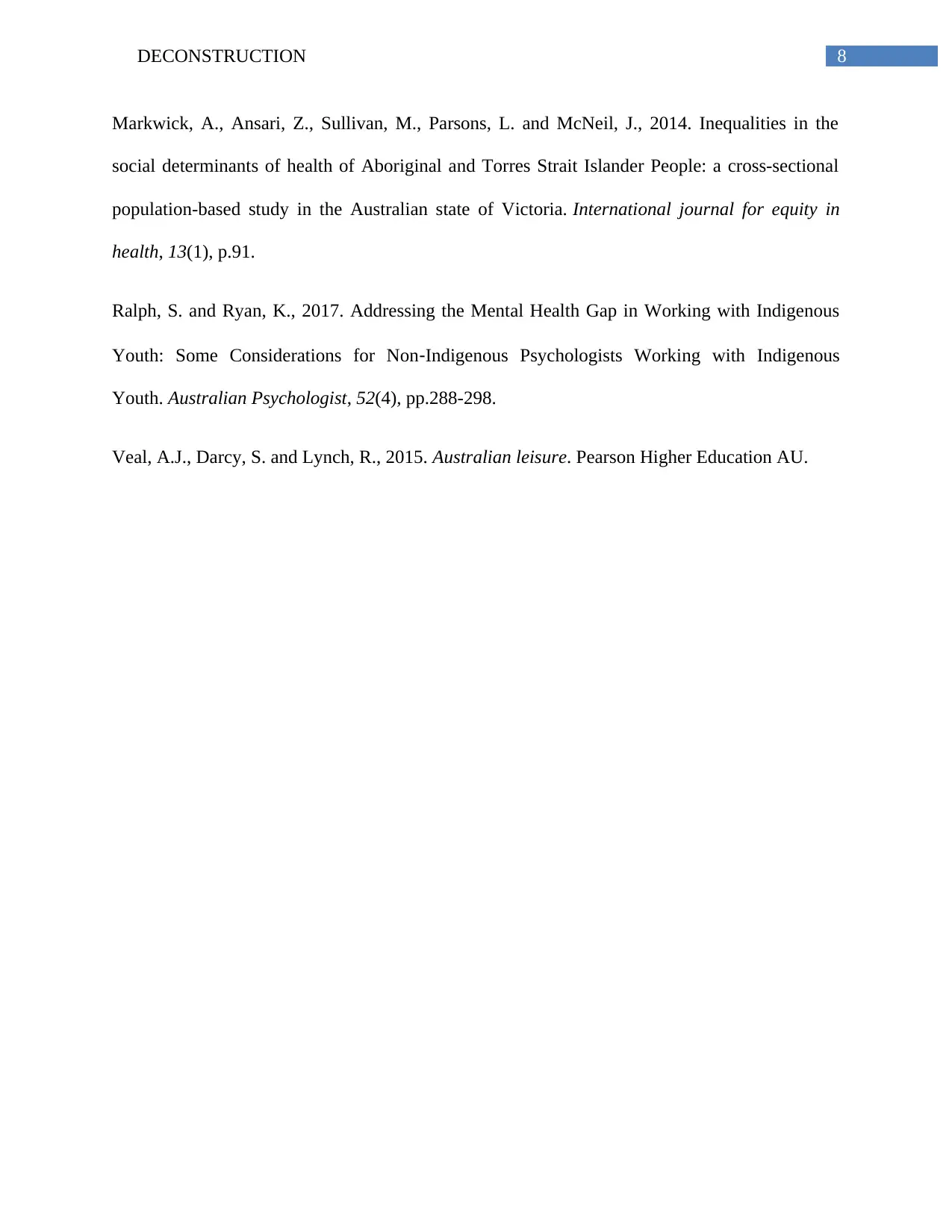
8DECONSTRUCTION
Markwick, A., Ansari, Z., Sullivan, M., Parsons, L. and McNeil, J., 2014. Inequalities in the
social determinants of health of Aboriginal and Torres Strait Islander People: a cross-sectional
population-based study in the Australian state of Victoria. International journal for equity in
health, 13(1), p.91.
Ralph, S. and Ryan, K., 2017. Addressing the Mental Health Gap in Working with Indigenous
Youth: Some Considerations for Non‐Indigenous Psychologists Working with Indigenous
Youth. Australian Psychologist, 52(4), pp.288-298.
Veal, A.J., Darcy, S. and Lynch, R., 2015. Australian leisure. Pearson Higher Education AU.
Markwick, A., Ansari, Z., Sullivan, M., Parsons, L. and McNeil, J., 2014. Inequalities in the
social determinants of health of Aboriginal and Torres Strait Islander People: a cross-sectional
population-based study in the Australian state of Victoria. International journal for equity in
health, 13(1), p.91.
Ralph, S. and Ryan, K., 2017. Addressing the Mental Health Gap in Working with Indigenous
Youth: Some Considerations for Non‐Indigenous Psychologists Working with Indigenous
Youth. Australian Psychologist, 52(4), pp.288-298.
Veal, A.J., Darcy, S. and Lynch, R., 2015. Australian leisure. Pearson Higher Education AU.
⊘ This is a preview!⊘
Do you want full access?
Subscribe today to unlock all pages.

Trusted by 1+ million students worldwide
1 out of 9
Related Documents
Your All-in-One AI-Powered Toolkit for Academic Success.
+13062052269
info@desklib.com
Available 24*7 on WhatsApp / Email
![[object Object]](/_next/static/media/star-bottom.7253800d.svg)
Unlock your academic potential
Copyright © 2020–2025 A2Z Services. All Rights Reserved. Developed and managed by ZUCOL.





